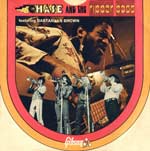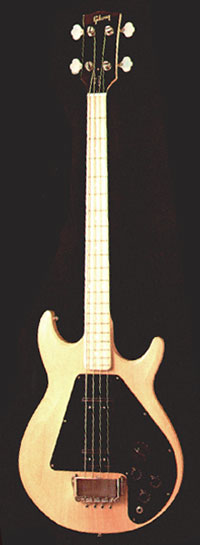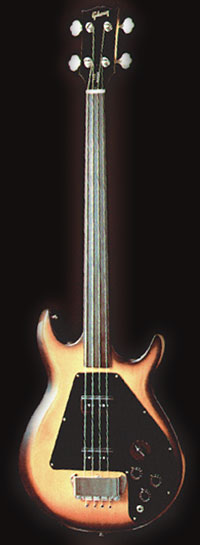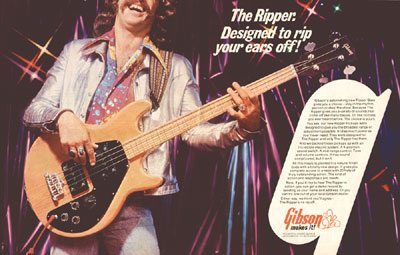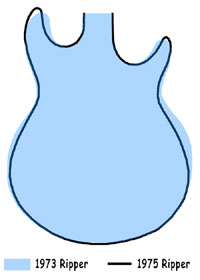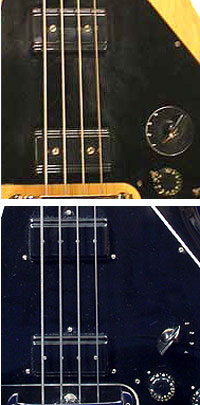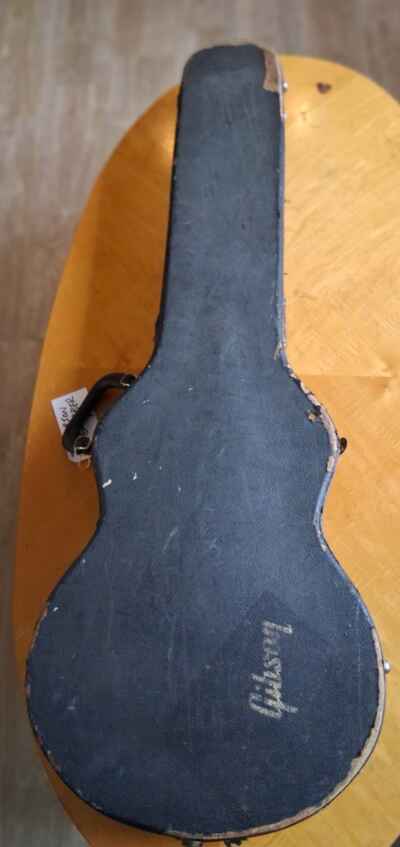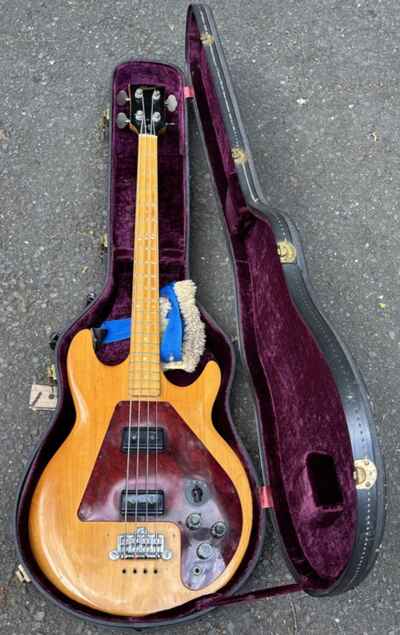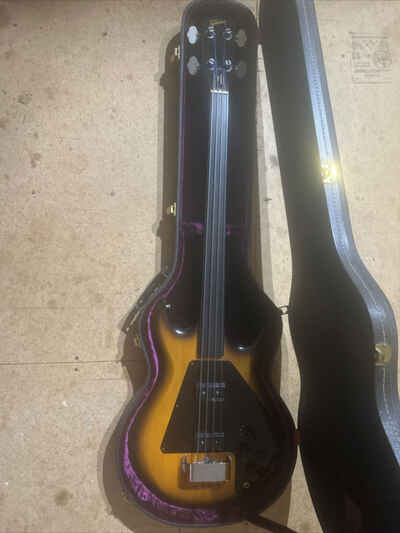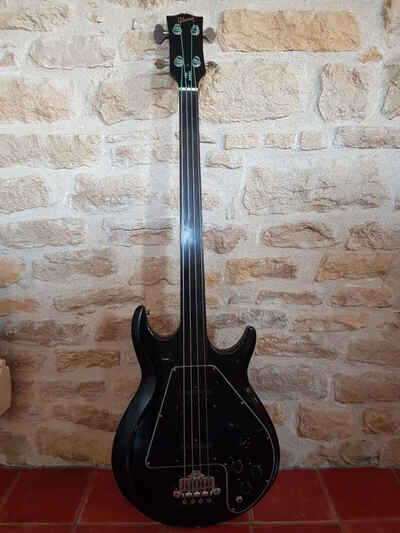The Gibson Ripper bass was launched in 1973, as something new for the guitar buying public, who had began to tire of the EB basses that had dominated the 1960s. As one of their mid seventies adverts proclaimed, they haven't been hanging about for fifteen or twenty years. Mahogany was out - the earliest Ripper bodies were manufactured from maple, though in 1975 to 1976 alder was used before going back to maple in 1977.
Gibson L-9 S Ripper specifications
The Gibson Ripper, (along with the Gibson L6-S guitar) were designed by Bill Lawrence who was working for Gibson at the time. But Lawrence had a long history working with German brand Framus - and about the same time he came up with the Ripper and L6-S for Gibson, he designed the Nashville (guitar and bass versions) for Framus. These actually have a lot of similarities both in looks and circuitry, and are arguably the best guitars produced by the brand.
Economic pressures in the 1970s meant the L-9S had to be affordable. A good quality bass, certainly, but no expensive inlays or finishes, plastic pickup covers, and controls and pickups mounted on the scratchplate (reducing production time and costs, compared to mounting in the wood).
It was still a big bass, compared to Gibson's previous models. Long scale (there was no short-scale equivalent), with a big rounded body. All-maple ones can be quite heavy. Hardware consisted of the then brand new Ripper humbucking pickups, Gibson 3-point bridge, with chrome cover; and usually Schaller BM machines.
But the controls were interesting. Bill Lawrence developed the Ripper pickups and 'Q-system' electronics, which had an impressive array of tones, if a little difficult to find them all again... So Gibson put out a fantastic vinyl record with a demonstration of the bass; including suggested Q-system settings, and some funky live performances by Richard Evans and Dartanyan Brown of Chase.
The Ripper bass was available as a standard fretted instrument (left) and from 1975 as a fretless, though only 898 fretless Ripper were shipped between 1975 and 1979; around 10% of the total. Have a look and a listen to a fretless Gibson Ripper
The exact Ripper specifications can be seen in the 1975 Gibson bass, 1978, 1980, and finally (as a close out model) 1981 catalogs.
Some more examples...
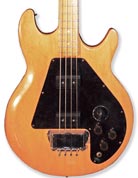 1974 L-9S Ripper
1974 L-9S Ripper
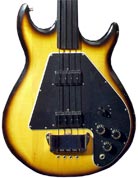 1977 L-9SF Fretless Ripper
1977 L-9SF Fretless Ripper
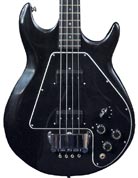 1978 L-9S Ripper
1978 L-9S Ripper
Gibson Ripper bass shipping totals
The L-9S shipping figures are taken from Larry Meiners book Gibson Shipment Totals. This data stops at 1979, though small numbers were shipped at least as late as 1982.
| 1973 | 1974 | 1975 | 1976 | 1977 | 1978 | 1979 | total | |
| Ripper Fretless L9-FS | 95 | 107 | 76 | 74 | 352 | |||
| Ripper Fretless L9-FS Tobacco Sunburst | 108 | 255 | 57 | 79 | 47 | 546 | ||
| Ripper L9-S Ebony | 19 | 426 | 118 | 734 | 442 | 466 | 198 | 2403 |
| Ripper L9-S Natural Maple Gloss | 20 | 3075 | 715 | 351 | 187 | 4348 | ||
| Ripper L9-S Natural Satin | 1057 | 1185 | ||||||
| Ripper L9-S Tobacco Sunburst | 5 | 22 | 52 | 19 | 28 | 126 |
Gibson Ripper bass variations
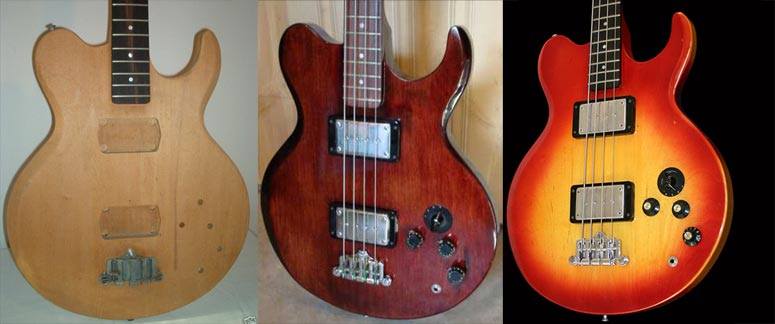
Gibson Ripper prototypes
Prototype A small batch of Ripper prototypes/samples were produced in 1973, with a different body style; a few of which have surfaced over the last few years. There were several variants, with differing circuitry, finishes and body woods. Perhaps other details too? Note the shallow 335-style top cutaway, and deep lower cutaway. These early basses had none of the money-saving components of the final production model; pickups and controls are mounted directly to the body, and the electronics are accessed from the back. The examples shown here include one that has been stripped entirely, one in Walnut (or is it a faded Cherry over mahogany?), and one in Cherry Sunburst. None appear to have had a maple fretboard.
These were the guitars demonstrated at the June '73 NAMM show in Chicago - UK music magazine Guitar reported the new L65 (sic) guitar and L95 (sic) bass; "the neo-cutaway design on these models is similar to the new semi-acoustic Les Paul Signature guitar and bass" - note at this stage there is no mention of the name 'Ripper'.
Prototype 2 The earliest photographed guitar clearly identifiable as a Ripper appeared in the January 1974 guitar magazines, and is pictured here. This would also have been built in 1973. This Ripper is very different from all later guitars featuring a smaller pickguard (only one pickup is mounted in it), 2 EB style humbuckers with surrounds and no bridge cover (also no strung through body?).
Dartanyan Brown, bass player with jazz rock group Chase was one of a number of artists given early Rippers to 'road-test'. He recalls this bass well.... "that was one of several 'first drafts' that Bruce (Bolen) reviewed with me, Greg Lake and probably a few others. The instrument pictured has a beveled edge; that's because it was originally flat-edged (like a telecaster bass) and I thought it very uncomfortable so they were bringing various bevel/contour designs. They needed something for the print ad (upcoming Christmas season) so they grabbed that one. It was just a mock-up for an ad that was produced way ahead of the actual guitars on the assembly line." Dartanyan went on to record a track called Base Meant for a Gibson Ripper publicity disk in 1974.
Gibson Ripper bass production models
There were some other differences between the earliest and latest Rippers other than choice of body wood. Most notably in body shape, but also varitone selector markings and pickup mounting. The earliest models were wider bodied, but with short rounded horns, and tortoiseshell pickguards ranging from deep red to almost black. By late 1974 with the change to an alder body, the horns were lengthened, and sharpened, whilst the body became slightly narrower.
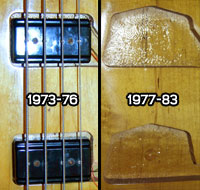
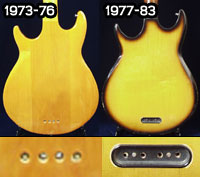
The next modifications came in somewhere in late 1976, early 1977; the pickups had previously been mounted with 2 screws going through the centre of the pickup itself, however now this was replaced by 3 screws attaching it to the scratchplate. This required modification of the pickup routes; from rectangular, to a five-sided shape.
At around the same time, the varitone position labels were etched into the scratchplate, rather than using a label ring similar to an EB3 bass, and the back of the body now had a recessed black metal plate through which the strings pass, rather than individual string holes. Pickguards (at least on some instruments) were now five-ply b/w/b/w/b. All of these differences are illustrated in the pictures to the left.
The Ripper was still featured as late as the 1983 catalogue, with no changes in specification, except for an ultra-safe "Posi-Lok" strap button fitted to all Gibson basses of this period. Few guitars actually shipped in the 1980s.
Ripper bass copies and reissues
In the mid 1970s, Gibson 'lawsuit' copies were everywhere. On first glance, some guitars were hard to distinguish from the real thing, even using very similar hardware. Rippers branded Aria, Cortez, Shaftesbury, Ventura, Westminster - to name but a few - were being produced in Japan and imported by European and American dealers.
More recently, Gibson and Epiphone have both reissued the Ripper, if only in very limited runs.
Gibson Ripper Bass FAQ
Frequently asked questions about the Gibson Ripper
Is it L9-S or L-9S?
Both! From 1973-1976, Gibson literature describes this as the L9-S, from then on as the L-9S.
Gibson Ripper bass for sale
1970's Gibson Ripper Bass Guitar and Case
Portland, Oregon, 972**, UNITED STATES OF AMERICA
$2500
1974 GIBSON GRABBER / RIPPER BASS CASE - made in USA
Kaufman, Texas, 751**, UNITED STATES OF AMERICA
$370
... more
Gibson Ripper Bass Guitar Natural Finish with Case Early 1970s
Hawleyville, Connecticut, 064**, UNITED STATES OF AMERICA
$2500
I am not a player looks to be all original but i can??t tell probably missing the tail cover
... more
1974 Gibson Ripper L9-S Bass Natural | Vintage Icon | Original Case Included
Salt Lake City, Utah, 841**, UNITED STATES OF AMERICA
$2299
Up for sale is a stunning 1974 Gibson Ripper Bass in its classic Natural finish, complete with its original hard-shell case. This vintage bass is in very good condition and is ready to deliver exceptional performance with that unmistakable classic Gibson tone
Condition & Features:
Cosmetic Wear: This bass shows some light scratches, dings, and general wear throughout, with noticeable wear on the ... more
Gibson Ripper (L9-S) Bass Guitar with Seymour Duncan
New Florence, Pennsylvania, 159**, UNITED STATES OF AMERICA
$3500
This bass is in very good condition. There are a few small marks located in the pictures. Feel free to ask questions, can send more pictures. Must have at least 10 positive comments to purchase. For sale in the United States Only
... more
1974 GIBSON GRABBER / RIPPER BASS CASE - made in USA
COLOGNE, GERMANY
€279
1974 GIBSON GRABBER / RIPPER BASS CASE - made in USA:
+ black tolex, has a lot of wear & rips
+ bottom is loose=check pic 7
+ strap that holds case open is gone
+ deep purple interior, has stains
+ 1 latch is broken=check last pic
+ handle was replaced
+ all feet on bottom are missing
Over 1000 more
GUITARS-BASSES-PARTS in our OTHER
AUCTIONS !!!!
TAKE A LOOK !!!... more
1975 Gibson Ripper Bass Guitar
Hertford, SG13***, UNITED KINGDOM
£2719
Just been refretted and set up by a great great tech, very detailed report available on request. Sounds great and welcome to come and try. Piece of guitar history and a great example of this model
Previous headstock break, great repair does not effect playing?? adds more character
Any more questions get in touch,
Local collection available or if you want to organise a courier that's fine
I can't send in the... more
1974 GIBSON GRABBER / RIPPER BASS CASE - made in USA
COLOGNE, GERMANY
€333
+ black tolex, has a lot of wear & rips
+ rips & material missing at the plastic surround
+ strap that holds case open has a rip
+ deep purple interior, has some wear
+ all latches work fine
+ handle is gone
+ top of case is at headstock front resting on the bottom part=NOT OVRRLAPPING AS USUAL
+ all feet on back are missing
Over 1000 more
GUITARS-BASSES-PARTS in our OTHER
AUCTIONS !!!!
TAKE A LOOK ... more
Basse Gibson Ripper Fretless Black Ebony ~ 1976
Balanod, 39***, FRANCE
€2550
... more
I spotted a 1976 black ripper with a tort scratch plate. https://reverb.com/item/5171149-1976-gibson-ripper-bass Is this rare or some after market change by a PO?
Anyone have any info/estimates as to how many fretless ebony rippers were ever made?
All of the production runs and numbers produced are in this article.
I am trying to locate a switch control for my 1974 L9-S Ripper as well as a set of adjustable pick-up magnet screws and pick-up mounting screws. Can anyone please assist me?
Why are there no cherry sunburst finish Rippers not shown in the shipping figures? Gibson certainly did make them. Mark Evans of ACDC had one early on.
The cherry burst Rippers were said to be a very limited run for Nam 75, maybe 6 but little interest led to the tobacco burst.
If you can find a sunburst Ripper, BUY IT! Those, for some reason, are the best-made Rippers ever.
I just found a 78 black (ebony) ripper with the newer body style and ebony board. Great condition (maybe 8.5/10) and great playing bass, but i'm not sure what it is worth (it seems a tad expensive). I don't want to overpay. What is a really nice all original Ripper worth. With case too. Thanks, Jason
The second body style Rippers use the same cases as the Grabber and G3 - these are fairly frequently seen on ebay, and you should be able to pick one up in the region of $80. Maybe less for a beater. It probably is worth getting the original case if you can.
Cool basses. I wanted one of these throughout my youth.. always too expensive :( but I've got one now ( as of last week ) and I can't put it down. I think it's changing the way I play. I need a case though. What fits? TIA

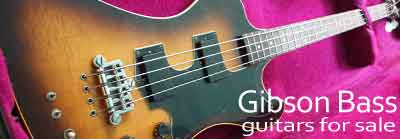
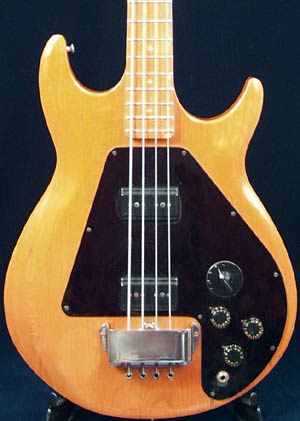 1976 Gibson Ripper
1976 Gibson Ripper